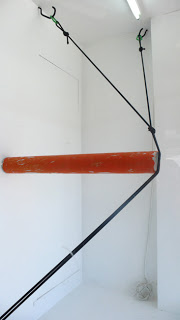John Hurrell – 27 April, 2009
Looking at it slightly from one side, and not frontally, the work seems like a synthesis between Kenneth Snelson and the Russian Constructivist el Lissitsky in the way it explores temporary methods of creating tension for holding forms in place. However, in a reflexive sense, the elastic can be interpreted as a trope for the supportive mechanisms within the artworld that operate behind each show, those connecting social structures that enable the work to be seen and taken seriously.
Auckland
Rob Gardiner
Last year’s touring National Drawing Award, due to its lack of any focussing structure, was one of the least satisfying exhibitions to grace ARTSPACE for some time. It may have been sprawling and indiscriminate, but among the handful of included quality works was an image of a photographed corner with drawn and collaged linear elements straddling the space. The research Rob Gardiner was doing with that drawing has now developed into this window installation, an examination of sculptural space and the psychological cues within it that enable us to experience depth.
The setting now though is not a corner but a box that is transparent on two sides. Opposing planes, not adjacent ones, are the key elements - as is ocular access permitted through the properties of light. The main component is a cardboard tube lightly painted orange with rough strokes, projecting from the far wall and held in position by three black elastic cords (Y-shaped when joined up) with hooking links. The latter are painted green to match the ends of the fluoro tube in the ceiling.
When we look through the glass window and down the dark tube, we can see that the other end is pressed against a short horizontal wooden strip. That strip’s thickness holds the tube so it cannot be flush with the wall, enabling light to bounce off the white plane and enter the long cylinder’s depth to rake across its internal lining.
The distant horizontal strip is lined up with the top end of a vertical length of tape extending down the inside of the window pane. Peering down the tube, it is like squinting through a telescope or gun sight to examine the art display space’s backing wall.
Looking at it slightly from one side, and not frontally, the work seems like a synthesis between Kenneth Snelson and the Russian Constructivist el Lissitsky in the way it explores temporary methods of creating tension for holding forms in place. However, in a reflexive sense, the elastic can be interpreted as a trope for the supportive mechanisms within the artworld that operate behind each show, those connecting social structures that enable the work to be seen and taken seriously. ‘The Given as an Art Political Statement’ as Billy Apple and Wystan Curnow once put it.
Gardiner is originally from Hamilton, and part of a community of older artists linked to the Waikato (other examples being Campbell Smith, Joan Fear, and Ruth Davey). Living in Auckland for the past few years it seems has done wonders for his practice. This work looks fresh, current and energetic. Perfect for a site such as this.
- John Hurrell



 Two Rooms presents a program of residencies and projects
Two Rooms presents a program of residencies and projects Advertising in this column
Advertising in this column



This Discussion has 0 comments.
Comment
Participate
Register to Participate.
Sign in
Sign in to an existing account.